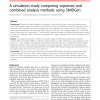Free Online Productivity Tools
i2Speak
i2Symbol
i2OCR
iTex2Img
iWeb2Print
iWeb2Shot
i2Type
iPdf2Split
iPdf2Merge
i2Bopomofo
i2Arabic
i2Style
i2Image
i2PDF
iLatex2Rtf
Sci2ools
99
Voted
WABI
2009
Springer
2009
Springer
A Simulation Study Comparing Supertree and Combined Analysis Methods Using SMIDGen
Background: Supertree methods comprise one approach to reconstructing large molecular phylogenies given multi-marker datasets: trees are estimated on each marker and then combined into a tree (the “supertree”) on the entire set of taxa. Supertrees can be constructed using various algorithmic techniques, with the most common being matrix representation with parsimony (MRP). When the data allow, the competing approach is a combined analysis (also known as a “supermatrix” or “total evidence” approach) whereby the different sequence data matrices for each of the different subsets of taxa are concatenated into a single supermatrix, and a tree is estimated on that supermatrix. Results: In this paper, we describe an extensive simulation study we performed comparing two supertree methods, MRP and weighted MRP, to combined analysis methods on large model trees. A key contribution of this study is our novel simulation methodology (Super-Method Input Data Generator, or SMIDGen) that ...
Related Content
| Added | 25 May 2010 |
| Updated | 25 May 2010 |
| Type | Conference |
| Year | 2009 |
| Where | WABI |
| Authors | M. Shel Swenson, François Barbançon, C. Randal Linder, Tandy Warnow |
Comments (0)

